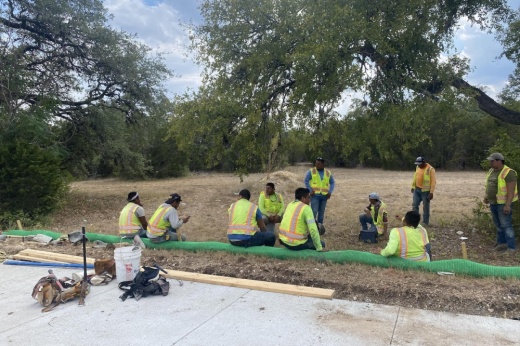This year, Austin hit record-high temperatures at least 27 times, had more than 60 triple-digit days and saw an average high of over 103 degrees Fahrenheit in July, according to the National Weather Service. Drought conditions worsened across Central Texas and much of the area saw in elevated risk of wildfires. While the NWS predicts most days in September will remain below 100 degrees, the oppressively hot summer has many Austinites considering what the future holds—both adapting to short-term needs and addressing long-term changes.
“It’s concerning because we may be heading in a direction where this might be more the norm,” said Jay Banner,
professor in the department of geological sciences and director of the Environmental Science Institute.
Central Texas’ hot future
Over the years, Central Texas has seen Southwest desert conditions spread east, bringing worse droughts and higher temperatures, Banner said. In a normal year, Austin averages about 40 days of triple-digit temperatures. By the end of the 21st century, it could reach 120 days, Banner said.
Using a climate model to simulate “business as usual”—or no significant changes to the factors causing climate change—Banner said the area could expect about four months of triple-digit days.
The tangible effects of hotter and drier conditions include loss of vegetation, livestock and crops, and significant changes to Austin-area bodies of water, such as Barton Creek. “The future could be a very different world for Texans,” Banner said.
Surviving the heat
A few years ago, Kasey Lansangan, an electrician and president of the IBEW Local Union 520, was digging a trench when his hands started cramping. When he got home, his wife noticed he was not acting right.
Lansangan later learned he was suffering from heat stress or heat cramping, which is a precursor to heat stroke or exhaustion.
The symptoms of heat exhaustion include general weakness and heavy sweating, a weak but fast pulse. Heat stroke includes a rapid and strong pulse, loss of consciousness and disorientation, according to the NWS.
“When you are out there, there doesn’t seem to be even a recollection of anything being hotter,” Lansangan said.
Now as president of the union, Lansangan stresses the importance of education about the heat and precautions on the job site.
“If that saves one life, that is worth it, but if you save one life you are probably saving more without knowing it,” Lansangan said.
The union negotiates protections with builders, such as providing water, holding toolbox talks—jobsite conversations—about heat and enforcing Austin’s mandatory Rest Break Ordinance, which is one 10-minute break for every four hours.
Lansangan said about 15% of Austin-area electricians are in a union, and estimates the other construction trades see a similar representation.
Especially for those individuals who are not represented by a union, Lansangan said it is important the city continue to find ways to protect workers.
Brittney Baize, director of development and communications for Family Elder Care, a nonprofit that helps older adults and people with disabilities with health and wellness, helps oversee the summer fan drive every year. The drive provides fans to low-income individuals over age 65.
“We are seeing unprecedented demand, which I feel like I see every summer, but this summer is record-breaking,” Baize said.
While most Texas homes are equipped with air conditioning, many elderly residents cannot afford repairs when the system breaks or cannot cover an increase in their electricity bill, Baize said.
“Heat is the No. 1 weather-related killer [nationally],” Baize said. “For older adults or children or those with a medical issue, they struggle to regulate their body temperature. When they get hot, it can be really dangerous.”
Making changes
Throughout the summer, the city of Austin has encouraged residents to utilize cooling centers around the city.These centers are places such as libraries, park facilities and community centers that are regularly open to the public.
On July 11, in 109-degree weather, Austin Council Member Natasha Harper-Madison and her family took refuge at City Hall due to a power outage at her East Austin home.
She posted on the council messaging board about the experience and urged her fellow councilors to look for ways to better support residents through the ongoing heat wave and hot summers to come.“As a matter of environmental justice, we are obligated as a municipality to have in place the sort of resilient strategies that will protect the least among us even in the worst of situations,” Harper-Madison said.
A few weeks earlier she had called for a special meeting to discuss heat-related issues, but it failed to reach quorum.
That same day, June 28, Assistant City Manager Rey Arellano put out a memo detailing the Austin-Travis County Heat Plan.
The plan includes extending the hours of cooling centers during excessive heat warnings—typically cooling centers are only open during normal business hours—and increasing surveillance of vulnerable populations during heat advisories.
The city has taken other precautions this year, including opening the Austin Resource Center for the Homeless during the day—typically it is only open in the evenings—to offer unhoused individuals a place to cool off and has coordinated water distribution at homeless encampments.
Beyond concerns around individual safety, local authorities have taken action to address drought conditions and wildfire concerns. In June, Austin entered Stage 1 water conservation standards, and Dripping Springs entered Stage 3. Travis and Hays counties have been under a burn ban for most of the summer. Travis County passed a resolution asking the Lower Colorado River Authority to speed up its conservation plan.
Even as residents find ways to deal with the hotter temperatures, Banner said it is never too late to begin making changes to address climate change and stave off the worst-case scenario for the future.
“I think it is easy to think, ‘Wow this is doom and gloom, and this doesn’t sound good ... and that is decades off in the future,’” Banner said. “I would say it should be a cause of concern, and a cause for concern now, because we can act now.”





